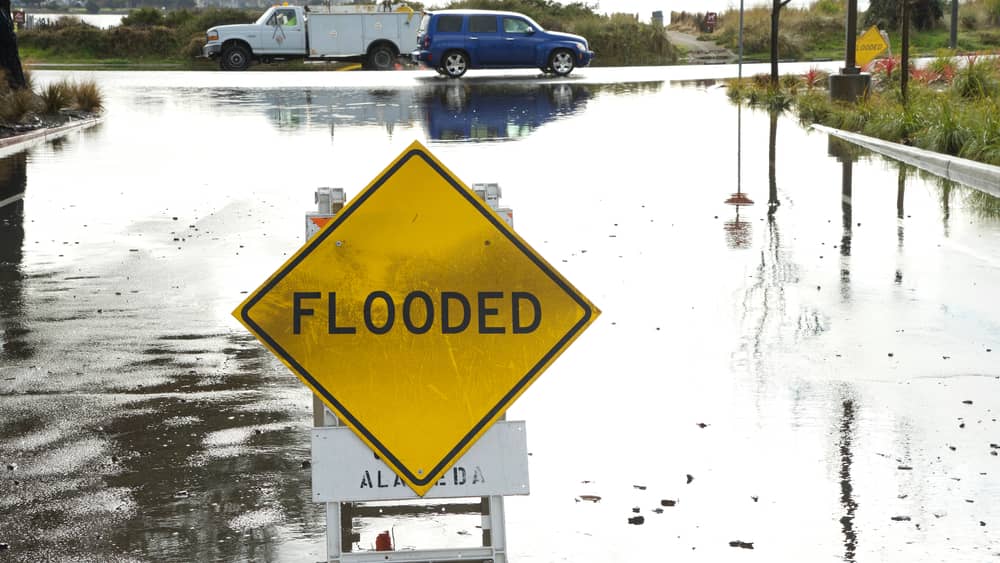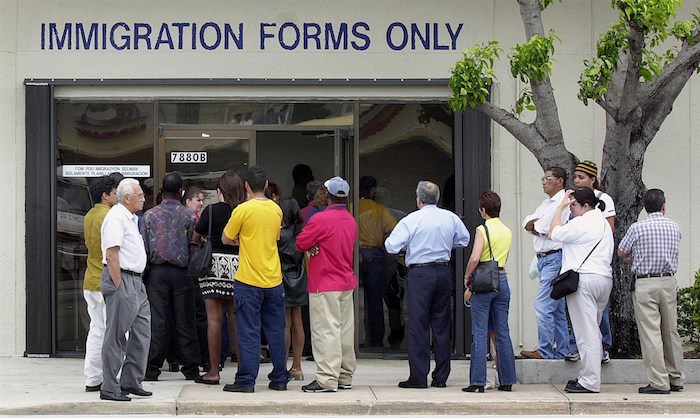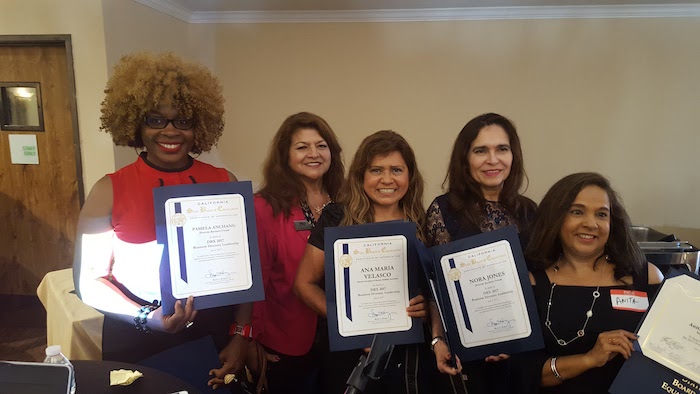Severe storms battered California through January 19. It’s still possible to be prepared. Experts working on the frontlines provided an overview of the impact of the storms and what to expect in the near future; a guide for how to keep yourself and your loved ones safe at home or on the road in extreme weather; where flood victims can go for recovery resources. Executive Director of California Black Media, Regina Brown Wilson moderated the Ethnic Media Services (EMS)briefing. Speakers included A representative from the California Governor’s Office of Emergency Services (Cal OES) and other California state agencies.
Diana Crofts-Pelayo, Assistant Director of Crisis Communication and Public Affairs at the California Governor’s Office of Emergency Services (Cal OES). Previously, she served as Chief of Community Outreach and Resilience at Cal OES. From 2018-2020, she was the Assistant Deputy Director of External Affairs and Media Relations for the California Complete Count – Census 2020.
She gave an overview of the recent storms that have impacted the state. The agency she shared is the critical hub to direct state emergency activities and harness the expertise of the whole state government while working with our local Federal and tribal Partners. “We firmly believe every Californian regardless of age, ability, income or language deserves culturally competent education to prepare for, respond to and recover from disasters including flooding”.The state has engaged a trusted network of community-based organizations, tribal governments, and community emergency response teams across the state to provide accessible in-language information during these trying times. We have experienced destructive flooding of homes, businesses, and communities, including levee breaches, mudslides, hurricane-force winds in many of our communities, and even a tornado. These storms are among the most deadly disasters in the modern history of our state. Unfortunately, there have already been 20 reported deaths. To keep California safe the full weight of the state and federal government has been rapidly deployed to protect impacted communities. The state Is committed to continuing to support California communities and maximizing state and federal aid to those who have been adversely impacted by these winter storms. On January 12th, Governor Gavin Newsom requested an expedited major disaster declaration. President Joe Biden approved this major disaster Declaration on January 14th for three specific counties: Merced, Sacramento, and Santa Cruz. What a major disaster declaration actually means for you. The president can declare a major disaster declaration for any natural event that the president believes has caused damage of such severity that it is beyond the combined capabilities of state and local governments to respond. A major disaster declaration provides a full wide range of federal assistance programs for individuals and public infrastructure. So, following that major disaster declaration, Cal OES continues to work with FEMA to maximize Aid and support communities during this storm event. We have made a request for additional counties to be added to the major disaster declaration to receive individual and public assistance as warranted by the results of assessing the damage locally. While damage assessments are critical to establishing a basis to add a county as a designation in the major disaster declaration, it’s imperative that emergency response and life-saving activities still remain a priority and go uninterrupted during storm conditions. So we’re committed to coordinating with local officials to rapidly bring these assessments and add any additional counties as appropriate. It’s not too late to be prepared for the next disaster, it is incumbent upon us all to talk to loved ones, family, and friends about emergency plans should another storm happen or an earthquake, or even a wildfire later this season. So have those conversations with your family now, have an emergency kit ready if you need to leave your house quickly, have a kit if you need to stay at home, and then start communicating and checking in with loved ones also helps be part of this overall culture of preparedness and resilience that we can have here in California.
Vance Taylor, Chief, Office of Access and Functional Needs, Cal OES. Luis “Vance” Taylor is the Chief of the Office of Access and Functional Needs at the California Governor’s Office of Emergency Services. Vance is responsible for ensuring the needs of individuals with disabilities and persons with access or functional needs are identified before, during, and after disasters and integrated into the State’s emergency management systems.
As everybody knows we have been going through a pretty rough patch with atmospheric river, after atmospheric river and atmospheric river, and even though we have a break in the weather we know that it’s like anything that could change and more rain could be on its way. What we recognize is that any time there are these types of disasters, there are individuals who are disproportionately impacted by those disasters. We are talking about older adults, we’re talking about people with disabilities, we’re talking about people who are economically disadvantaged or transportation disadvantaged, people with access to functional needs and so to ensure that our emergency management systems programs and services are being rolled out in a way that is equitable, and accessible to everyone is a top priority for the governors and Cal OES collaboration with FEMA. I want to make sure everybody understands that we are working to ensure our systems are going to be working for everyone. As a part of that, we are looking at how do we leverage the resources made available through this major declaration that was approved by the president on the 14th?
If you live in one of the three approved counties and we anticipate other counties will be brought in you’re going to be eligible to apply for federal assistance through FEMA. And some of that means being eligible potentially for grant money which means being able to have essential items such as furniture or durable medical equipment replaced. It means potentially having assistance with rental aid, it can also mean being provided with housing and other needs assistance; things as eyeglasses, hearing aids, and other assistive devices. Individuals will also be able to apply for assistance, receive low-interest SBA loans, and other necessities that essentially help them essentially recover and financially to get back on their feet. In order to apply for that disaster assistance there is a phone number:1800-621-3362 that you can call. You can also use a FEMA mobile app or apply online. It’s important that everybody understands that these services are available in different languages and that if you need ASL or Captioning that those services are also available. To make sure that people are able to register, FEMA will be sending out disaster survivor assistance teams to shelters and approved areas. Those are individuals that are going to work to provide any support that’s needed in the application process For example if needed any language assistance is provided if there are issues regarding literacy they can read questions and explain questions and fill out Documentation for you. We are also going to set up in-person documentation fillers, that’s essentially going to be a service that will drive to locations for individuals so that people don’t have to get out of their way to drive to shelters or access services through other means. We are essentially trying to get to the community, take a one-by-one approach and make sure everyone that’s been impacted lives in an approved County is able to register for services. While all this is going on we want to remind people that just because it’s sunny today and out of hazards way we still have to plan so that we can have a resilient and independent and healthy tomorrow. so we are encouraging everyone, especially individuals who have access to functional needs, make an evacuation plan, think of five people who can help you evacuate, these are people who know you and your needs and are part of your circle. Make a list talk to them about your needs and also follow guidelines from local authorities, if they say you got to go, to the shelter or rather that you have to evacuate then please evacuate. Make sure you know what’s going on, sign up for free emergency alerts, and sign up for free emergency alerts at Calalerts.org.If you don’t know what’s going on you won’t know what to prepare for, or what is the appropriate action to take. So please sign up for alerts, have a plan, and if you live in an impacted area that’s been approved in the disaster declaration make sure you register for FEMA assistance.
Jason Wilken, Ph.D., MPH, the CDC Career Epidemiology Field Officer assigned to the California Department of Public Health. Jason Wilken, Ph.D., MPH, is a CDC Career Epidemiology Field Officer detailed to the California Department of Public Health. His areas of expertise are disaster epidemiology, emergency preparedness and response, and occupational factors in infectious diseases.
This information is intended for returning home after a flood and the best advice is really to avoid water whenever possible. Flood water can contain all sorts of things that are harmful to your health. It can contain toilet waste and bad germs, it can have hazardous chemicals including things like gasoline, and it can contain hidden heavy or sharp objects. Flood water is typically cloudy and murky and you can’t see very well in it and it’s very easy to become injured by a sharp or heavy object. Flood water can also be attacked by down power lines and floods can also cause the migration of animals so you can have live or dead animals in flood water that you might not normally come in contact with so the best thing you can do to protect yourself is to avoid coming into contact with or consuming flood water. Contaminated food or water can cause serious illnesses including diarrhea, And skin infections and children are of course, especially at risk based on their behavior so if you have children do not let them play in or near flood water. Don’t let them play with toys or anything that flood water has gotten wet until those items have been disinfected and always make sure they wash their hands with soap and water, and always before meals, that’s a good practice Point but during a flood, it is especially important. Next, if you must be in contact with flood water, wear rubber gloves and wear rubber boots. This is a very good way to protect your skin from contact with flood water, it’s a very good way of making sure that you don’t actually accidentally ingest flood water.
Flood water can be unsafe to drink and so is tap water if it has been contaminated with flood water. So if you are on Municipal Water, if you have tap water your local water authorities will let you know whether the tap water is safe to use or whether it has to be boiled, or whether it should not be used at all so keep tabs with your local water authorities they will tell you whether your tap water is safe to use. If you have a flooded well, then check with local environmental health or with your water department for advice on how to test and disinfect your well. Bottled water by itself is safe. But the sealed bottles of water could still have been in contact with flood water, so the outsides of those bottles were in contact with flood water can be contaminated and the best way to disinfect those sealed bottles is to boil them for one minute.
Flooding can also contaminate food and contaminated food is unsafe to eat so other than undamaged cans or metal pouches you should throw out any fresh or packaged food that had been touched by flood water and even in the case of sealed metal containers those should still be cleaned and the outside should be cleaned and disinfected before consuming what’s on the inside.
Cleaning and Disinfecting: the most recommended cleaner is a tablespoon of bleach into a gallon of water for cleaning utensils, and for clean surfaces, this is a good all-purpose cleaner but it’s very important that you should never combine cleaners, so bleach plus ammonia, for example, will actually cause chlorine gas to be created and that is something that can easily quickly overwhelm and incapacitate someone, so never mix cleaners. Use one tablespoon of bleach with one gallon of water for cleaning surfaces and utensils and finally drying your home and removing items that have been water damaged is your best route for preventing the growth of mold. Mold will grow on hard surfaces, you can contact your local health department for guidance on mold remediation. It’s important to get those items, those wet items out of your home and dry them as quickly as possible to prevent the growth of mold. After 48 hours of dampness, you can assume that there will probably be mold growth unless you’ve gotten to dry those surfaces.










